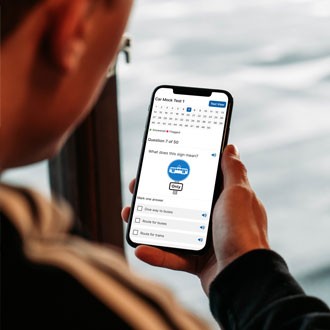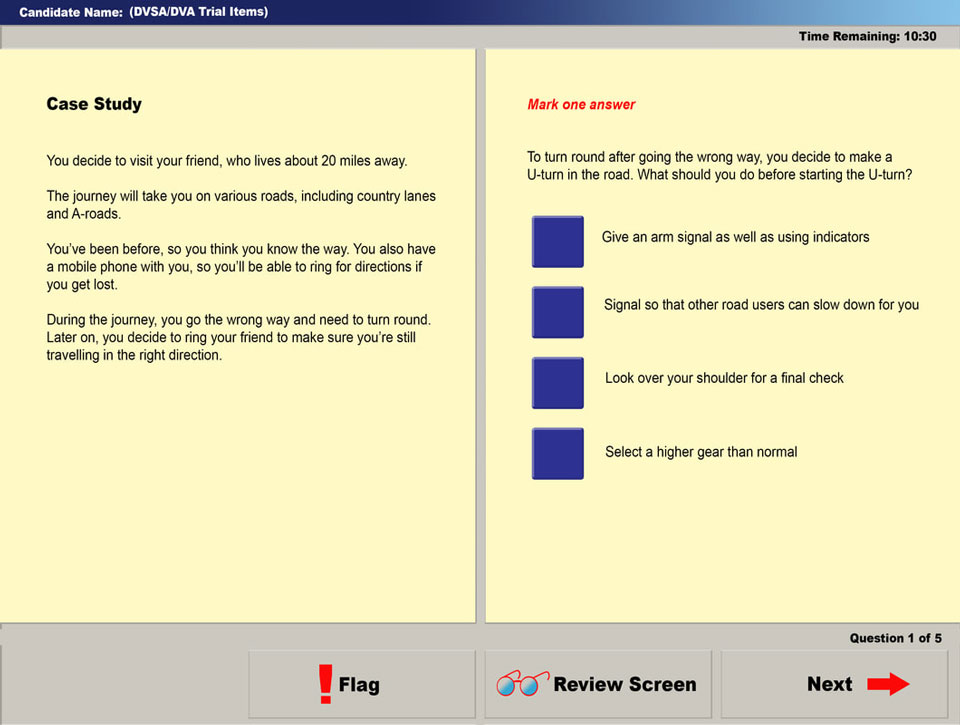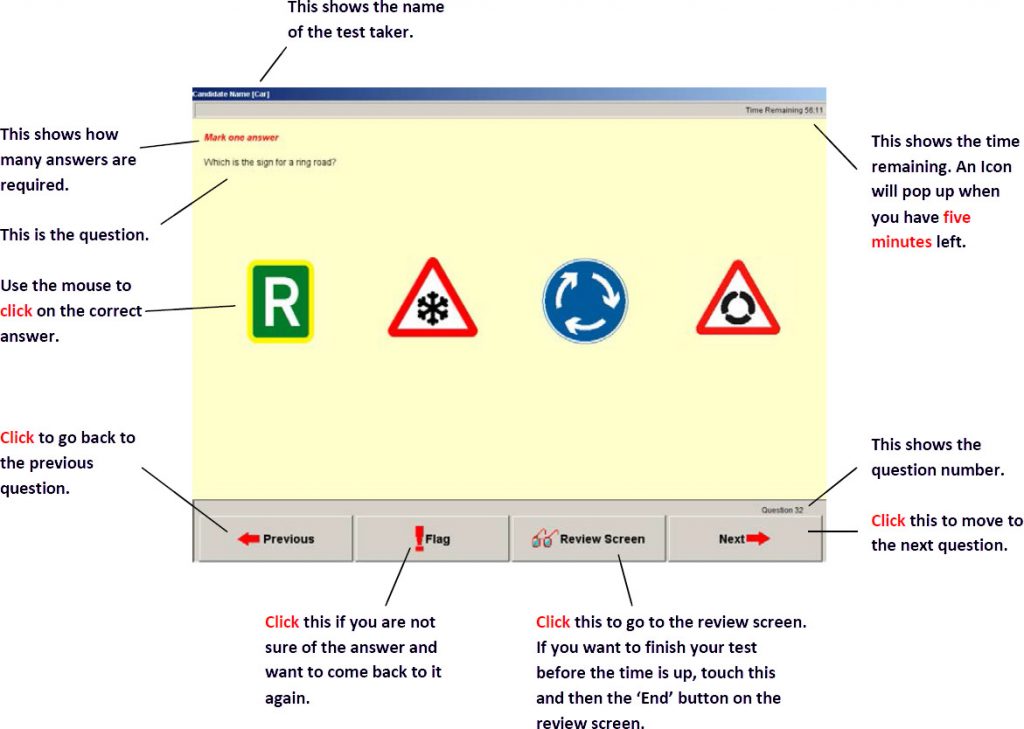Theory Test Practice 2025
- Complete Theory Test Preparation
- Structured Revision Courses
- AI-Powered Practice Questions








 500,000+ learners and counting!
500,000+ learners and counting!









About Us
We're here to make theory test preparation simple and effective with a proven learning approach. Our platform combines structured revision courses, a comprehensive question bank, AI-powered practice and realistic mock tests. By guiding learners step by step, we ensure every driver builds knowledge and confidence to pass the theory test first time.

How to Pass Your Theory
-
1
Know Your Way Around the Test
Understand what to expect before you start. Learn how the test works, what’s included, and what happens on the day so there are no surprises. -
2
Build Knowledge and Understanding
Learn the key topics inside out with our complete revision course, Highway Code, and detailed road sign practice. -
3
Master the Hazard Perception
Practise with realistic CGI and real-life clips that train your eyes to spot developing hazards quickly. -
4
Test Yourself
Take unlimited mock tests under real exam conditions. Track your scores and progress until you’re consistently hitting a pass mark. -
5
Book Your Test and Plan Your Day
Once you’re confident, book your official theory test and get ready for success. We’ll guide you through what to bring and what to expect.

Free Theory Test
- Answered
- Flagged
You have 57 minutes to complete 50 multiple-choice driving theory test questions. You need 43 out of 50 to pass the test. Answers may be reviewed after each question or you can wait until the end of the test for your final score. Good luck!
Do you wish to proceed?
Your All-in-One Theory Test Toolkit
From theory questions and mock tests to the Highway Code and hazard perception clips — everything you need to pass your DVSA theory test is right here. Select your vehicle and start learning instantly.
Over 601,950 Happy Drivers








 600,000+ learners and counting!
600,000+ learners and counting!









With over 601,950 happy drivers, our platform has become the go-to choice for theory test preparation. Learners love how easy, effective, and confidence-boosting our revision course, mock tests, and smart practice tools are.
-

Right questions and realistic hazard practice
I just wanted to say thank you for providing such a great tool for helping people to practice their theory test. I have been driving for 27 years and I want to get my full motorbike license. I paid for full access to all of your theory questions and hazard perception tests and it really helped me to prepare: I’m very pleased to let you know that I passed my theory test tonight with flying colours. Thank you, thank you, thank you!Neil HarrisMarch 2025
-

Everything I needed to pass
This course had everything I needed for both my theory and practical tests. You still have to put the work in, but the lessons are clear and easy to follow. I studied consistently, passed my theory on the first go and my driving on the second. Please don’t change a thing. Thank you!Carla MJuly 2025
-

Highly recommended
This website helped me pass my Car and HGV Theory Test. It really helped by providing real life situations. I would recommend this website for anyone doing their Car, Motorbike, HGV or PCV Theory Test. Thanks!Ajay AgarwalSeptember 2025
-

Helped me pass first time
I studied on this app for about four months, nearly every day, and it made all the difference. It helped me understand road rules, safety, and signs clearly. I passed both parts of my theory test first time. Would defo recommend!Bukola ElemideAugust 2025
-

I used this platform to pass my test
I subscribed to this website about two months ago. It has been extremely helpful for my theory test preparation. On test day, I finished the theory part in 20 minutes and there wasn’t a single question which I hadn’t seen in these practice tests. I passed on my first attempt. Thank you very much for such an amazing website!Babar KamalJuly 2024
-

Excellent Resource
My daughter passed after two weeks of using this site. After failing three times before! We’ll be using it again when my son’s ready.Nina SummerfieldJuly 2025
-

Passed my ADI test first time
I used TheoryTest.org.uk to prepare for my ADI theory test and passed on the first attempt. The questions cover everything you need, and the explanations are really clear. The mock exams feel just like the real thing.EthanAugust 2024
-

Perfect for LGV Learners
Great tool for anyone training for their LGV licence. I went through the mock tests repeatedly and passed all parts: theory, hazard perception, and CPC – first time. Excellent value and content.Steven B8 Mar 2025
-

The best Theory Test study tool
This site helped me understand every topic for my theory exam, from road signs to driving laws. The question explanations really made it stick. Couldn’t recommend it more.Gurjeet SinghDecember 2024
-

Helped me and my friends pass
After using this site, I passed my theory first time. And so did my friends I recommended it to. It’s so convenient being able to log in anywhere and study on the go.Rina AOctober 2025
-

Fantastic experience
Fantastic website! I used it for both my car and bike theory tests, and the practice sections were well-structured and easy to use. Passed both tests on my first try.LiamSeptember 2025
-

Great prep
Just wanted to let you know that your set of test questions, hazard awareness videos and case studies etc. are really first class preparation. Thank you.Seb RamseyJan 2025
-

Really happy!!
I passed my theory test yesterday thanks to your brilliant web site, thanks for your help. Practical next!Adeela
Frequently Asked Questions (FAQs)
Your questions, answered
What is a theory test?
The driving test comprises two parts – the theory test and the practical driving test. The theory test was introduced by the government in order to improve understanding of safe driving. Its role is to establish if you’ve understood the rules of the road and have a thorough knowledge of driving.
How is the theory test structured?
The theory test consists of two parts. The first part consists of 50 multiple-choice questions which test your knowledge of driving practices. The second part is a video-based hazard perception test which assesses your ability to respond to hazardous situations on the road. Both parts are taken on the same day.
Who sets the theory test?
The driving theory test is administered by the DVSA (Driver & Vehicle Standards Agency), a government agency that provides driver education and sets the theory and practical tests for cars and other vehicles. The DVSA is different to the DVLA (Driver and Vehicle Licensing Agency), which is responsible for keeping a database of drivers and vehicles in the UK and issuing licences. Both of these organisations are governed by the Department of Transport.
Please note, if you’re a resident of the Republic of Ireland, you will need to sit the Irish theory test.
When can I do my theory test?
You can do your theory test from the age of 17 onwards. You must have a provisional licence to take the test.
Can I do my theory test before taking driving lessons?
Although it is possible to sit the theory test before having any practical driving experience, it is advised that you start your practical lessons first. The content you need to cover for the theory test will make more sense after you have some experience on the road.
Can I sit my practical test before doing my theory test?
No. You must sit and pass your theory test before you’re able to do your practical test. The DVSA states that you must take your theory test certificate to the practical test.
What’s the theory test pass mark?
- The driving theory test pass mark is 43/50 for the multiple-choice test and 44/75 for the hazard perception test.
- The motorcycle theory test pass mark is 43/50 for the multiple-choice test and 44/75 for the hazard perception test.
- The HGV / LGV theory test pass mark is 85/100 for the multiple-choice tests and 67/100 for the hazard perception test.
- The PCV theory test pass mark is 85/100 for the multiple-choice tests and 67/100 for the hazard perception test.
| Vehicle | Multiple choice pass mark | Hazard perception pass mark |
|---|---|---|
| Car | 43/50 | 44/75 (14 clips) |
| Motorcycle | 43/50 | 44/75 (14 clips) |
| LGV | 85/100 | 67/100 (19 clips) |
| PCV | 85/100 | 67/100 (19 clips) |
How long is a driving theory test?
The entire theory test for car and motorcycle candidates will take approximately one and a half hours to complete. This consists of:
- 15-minute practice session before the start of the test (optional)
- 57 minutes for the multiple-choice section
- 3-minute break
- 20 minutes for the hazard perception test (including the introductory video)
The test is longer for HGV/LGV and PCV candidates and will take about two and a half hours to finish:
- 15-minute practice session before the start of the test (optional)
- 1 hour 55 minutes for the multiple-choice section
- 3-minute break
- 25 minutes for the hazard perception test (including the introductory video)
How many questions are there?
There are 50 questions for driving theory test and motorcycle theory test candidates.
LGV and PCV drivers must attempt 100 questions.
What score do I need to pass this part of the test?
You will need 43/50 if you’re taking a car or motorcycle theory test.
LGV and PCV candidates need to score 85/100 to pass.
How much time will I get to complete the questions?
If you’re a car or motorcycle theory test candidate, you will have 57 minutes to complete the test.
LGV and PCV candidates have up to 1 hour and 55 minutes to finish.
How many possible answers are there to each question?
All of the questions will have four answers to choose from listed after the question. One of these is correct and the other three are incorrect. A few years ago, some of the questions may have had more than four options to choose from, with several possible correct answers. This has since been changed by the DVSA.
What type of questions will I be asked?
You will be asked knowledge-based questions from a variety of different categories. For car drivers, there are 14 categories which encompass about 900 questions, 50 of which will be randomly chosen to appear in your test. These categories include:
- Attitude
- Documents
- Hazard Awareness
- Incidents, Accidents and Emergencies
- Motorway Rules
- Other Types of Vehicle
- Road and Traffic Signs
- Rules of the Road
- Safety and Your Vehicle
- Safety Margins
- Vehicle Handling
- Vehicle Loading
- Vulnerable Road Users
These categories will be slightly different for motorcycle, LGV and PCV candidates. Our practice material covers all of the questions and categories for the different types of vehicles.
What are case studies?
The last five questions of this part of the test will be centred on a case study. This case study will test your understanding and comprehension of a real-life driving scenario.
The case study will appear on the left-hand side of the screen, and the accompanying questions will appear on the right side. The case study may have a picture or diagram to complement the text. You will have the opportunity to re-read the case study as you respond to each of the questions.
Below is an example of the type of case study you will encounter during your test:
 What does the computer screen look like?
What does the computer screen look like?
Below is an example of how a multiple-choice question will appear during your test:
Keep in mind the following features:
- Only one question will appear on the screen at a time. The question and answers will be clear and easy to read. Some questions may be accompanied by an image. Answers to some questions may also be in the form of an image.
- There will be four answers to choose from. Select your chosen answer by clicking or touching the box next to the answer. If you need to change your answer, click or touch the box next to the answer and select another option. If the answers are in image format, like in the example above, simply click or touch the image.
- The time you have left will be displayed in the top-right corner of the screen. You will be alerted when you have 5 minutes left. There should be ample time to complete all the questions and check over them. If you have special needs, you may be granted extra time, but you will need to notify the DVSA of your condition upon booking your test.
- You can cycle through the questions using the Previous and Next. If you try to move to the next question without having given an answer, you will be alerted.
- If you’re not sure of a question, you can ‘flag’ it by clicking the Flag button. This will allow you to return to the question at a later stage to choose or change an answer, time permitting.
- The Review Screen button gives a summary showing the number of questions you have answered, the number of questions you have left unanswered and the number of questions you have flagged. You can revisit these questions via this screen. You can also finish the test session before the time is up by clicking the End button. A diagram of the review screen is below:
 All of our practice theory tests come with a “Test View” function which resembles the real test.
All of our practice theory tests come with a “Test View” function which resembles the real test.
Can I practice before the test?
Before the start of the test, you will be given a 15-minute optional practice session, allowing you to familiarise yourself with the format of the test and the navigation system. You will be given five practice questions to do. During this period, you may seek assistance from members of staff at the driving theory test centre if needed.
What is the hazard perception test?
The hazard perception test is the second part of the theory test and is a series of CGI video clips with the aim of assessing your ability to recognise developing hazards on the road. The test demonstrates your knowledge of potential risks associated with driving. This includes risks to you as a driver, risks to your passengers and risks to other road users.
Why do I need to take the hazard perception test?
The test was introduced by the DVSA in 2002 with the aim of ensuring that new drivers have a certain level of hazard awareness before taking to the roads. Newly qualified drivers are more likely to be involved in road traffic collisions in comparison to their more experienced counterparts, as a result of a lack of hazard awareness. In fact, learner drivers and new drivers are up to two seconds slower at identifying hazards than more experienced drivers. This is partly because they spend more time thinking about using the car’s controls and less time focusing on what’s going on around them. Studies have shown that the hazard perception test has successfully helped to reduce the number of accidents in the first year of driving.
How does the hazard perception test work?
Read more about the hazard perception test and how it works on our hazard perception test page. Consider signing up for an account for full access to our hazard perception video library.
How should I prepare for my driving theory test?
The best way to prepare for the multiple-choice part of the theory test is to practice our theory test revision questions and answers. The mock tests featured on our website encompass everything you will need to know for your test. We have also put together mock tests that contain questions specific to each of the 14 driving theory test categories. Keep attempting these mock tests until you gain a good understanding of the questions and are able to pass each time.
As well as theorytest.org.uk, there are other valuable resources which will aid you in your theory test revision. These are:
- The Official Highway Code – the theory test gets its questions from the Highway Code; you need to be familiar with it before your tests. Although quite a lengthy read, you should buy a copy and revisit it when you need to. We also have an online version on this website.
- Know your Traffic Signs – one of the lengthiest categories, and one that candidates don’t generally do so well in, is road signs. If you can, buy a copy. It will help you with your theory test revision and come in handy later on in your driving career when you come across unfamiliar road signs.
When should I start studying for my theory test?
You should give yourself plenty of time to study and familiarise yourself with the driving theory test questions and answers before booking your theory test. There is a large amount to cover, so ideally you will want to do small amounts over a longer space of time rather than cram it in at the last minute. Although people’s learning abilities vary, you should start your preparation at least a few weeks before you book your test. Remember, if there’s anything you’re unsure about, ask your driving instructor.
Do I have to learn all the questions and answers?
You don’t need to learn the entire bank of practice questions and answers. In fact, it would be quite hard to learn them all – there are over 900. The key is to understand the basics of driving and safety and apply this knowledge to the questions you come across. You will find that you can work out the vast majority of them. Many can also be answered by just applying a little common sense. There are some questions, however, which you will need to memorise. Questions relating to stopping distances are one such example.
Is the theory test hard?
This is a fairly common question. The national pass rate is about 50%, which would suggest that the driving theory test is quite difficult. You can increase your chances of passing by preparing and revising sufficiently. The hazard perception test is often considered the more difficult of the two parts of the theory test, but despite this, preparation for this section is often overlooked, leading to people failing the section and failing the theory test as a whole. Remember, you need to pass both parts of the theory test, so you should spend generous amounts of time preparing for them both.
How should I prepare for the hazard perception test?
The hazard perception test is more challenging to prepare for than the multiple-choice section because you won’t be able to practice with the real video clips that will be used during your test. This is because the whole idea of the hazard perception element of the theory test is to see how fast you can identify and react to hazards you haven’t seen before. If you have already seen the videos and identified the hazards beforehand, the test won’t be of much use. With that being said, we have received reports of individuals encountering some of the videos from our hazard perception video library in their actual tests.
The best way to prepare for the hazard perception test is to practice with as many video clips as possible. We have a number of CGI clips and real-life videos in our library, which will help you to prepare sufficiently. Your driving instructor should also be able to help you learn hazard perception skills and can give you plenty of practice in what to look out for when driving, how to anticipate hazards and what action to take when having to deal with different types of hazards. For this reason, it is important that you take driving lessons with a qualified driving instructor from a reputable driving school.
Are there any trick questions in the theory test?
No. The test hasn’t been designed to catch you out. Just make sure you read the question carefully and select the most logical answer.
How do I book my theory test?
You can book your driving theory test at the government website www.gov.uk/book-theory-test. Before you start, you will need the following to hand:
- Your UK driving licence number
- a credit or debit card
- an e-mail address (if you don’t have access to one, you will need to call DVSA theory test booking support and make your appointment over the phone).
Residents of Northern Ireland need to book their test at the following website: https://www.nidirect.gov.uk/services/book-change-or-cancel-your-theory-test-online.
You should be able to get a test time and date in the following two weeks. You should receive an email confirming the details of your booking shortly after making your application, along with a booking reference number.
Warning: Beware of unofficial driving theory test booking websites. Ensure the website you’re using has .gov.uk in the web address.
If you would prefer to book by phone, the number to call is 0300 200 1122. Phone lines are open from Monday to Friday, 8 am to 4 pm. Your appointment letter should arrive in the post within 10 days of making the booking.
How much does a driving theory test cost to book?
Car and motorcycle theory tests cost £23.
LGV and PCV theory tests cost £26 for the multiple-choice section, £11 for the hazard perception test and £23 for the case studies section.
English is not my first language. Can I do my theory test in a different language?
Candidates can only take the test in English or Welsh. Foreign language voice-overs or interpreters cannot be used.
Before April 2014, candidates were able to sit the theory test in 21 different languages, including Arabic and Urdu.
If you’re a Northern Ireland resident, click here for more details.
Where can I sit my theory test?
There are over 150 theory test centres in England, Scotland and Wales, and six in Northern Ireland. Find out what your nearest theory test centre is by asking your driving instructor or by entering your postcode here.
When can I do my theory test?
When booking your test, you will be able to select a time and a date of your choosing. Most theory test centres are open on weekdays and some also operate on evenings and Saturdays.
I have a health condition. Can I get extra support?
If you have a reading difficulty such as dyslexia, a disability or a health condition, you need to contact the DVSA before booking your test to discuss your options. See the government website for more details.
I haven’t received confirmation of my booking. What should I do?
If you have booked online, you should receive an email shortly after scheduling the test. Check your spam folder if you can’t see a confirmation email in your inbox. If you booked over the phone, your confirmation letter should arrive within 10 days. Contact the DVSA customer service number on 0300 200 1122 if you haven’t received confirmation of your test.
How do I change my driving theory test appointment?
You can change your driving theory test appointment online at https://www.gov.uk/change-theory-test. You can use this service to find an earlier date, move your appointment to a later date or change your test centre. Alternatively, call DVSA customer support on 0300 200 1122 from Monday to Friday, 8 am to 4 pm.
Changes must be made at least three clear working days before your test date, or you’ll have to make another payment. Sundays and public holidays aren’t considered working days.
Changes made at short notice are only permitted in the following scenarios:
- If you have an illness or injury and are able to provide medical evidence
- If you’re dealing with a bereavement
- If your theory test appointment clashes with a school exam
In these instances, you may rebook your test at no extra charge, although you won’t be issued a refund.
How do I cancel my theory test appointment?
If you want to cancel your theory test appointment altogether, you can do so online at https://www.gov.uk/cancel-theory-test. Alternatively, call DVSA customer support on 0300 200 1122 from Monday to Friday, 8 am to 4 pm.
Cancellations must be made at least 3 clear working days before the date of the test in order to receive a full refund. Sundays and public holidays aren’t considered working days.
When should I arrive at the test centre?
You should arrive at the test centre at least 15 minutes before your theory test is due to begin. This will give you enough time to sign in and take your seat.
What should I take to the test centre?
You must take your photocard provisional driving licence with you. You will need to give this to a member of staff so they can sign you in.
What happens before the test starts?
After you have signed in, you’ll be given access to a locker where you can store your mobile phone (which must be switched off) and other belongings. You will then be shown a document stating the rules and regulations of the test. Once you’ve read and understood this, you’ll give it back to a member of staff. You will then be ushered to the exam room where your provisional licence will be checked by the administrator before you can take a seat at a computer that has been assigned to you.
What’s the computer like?
Once you’re at your desk, your computer will be turned on and you will be logged in. The computer is like any other computer and is easy to use. Before the start of the test, there is an optional 15-minute practice session. You will be given 5 practice questions to complete. You’re advised to make use of this practice session to get used to your environment, the computer and the navigation system.
How long will I be at the test centre for?
If you’re a car or motorcycle candidate, you will be at the theory test centre for about two hours in total. You will spend:
- 15 minutes before the start of the test signing in and getting ready
- 15 minutes doing a practice session (optional)
- 57 minutes to complete the multiple-choice part of the test
- 3 minutes taking a break
- 20 minutes to complete the hazard perception test
- 10 minutes waiting for your result
How should I approach the test?
- Keep calm and relax – on the day of the test, do what makes you feel relaxed, such as going for a walk before the test. Give yourself plenty of time to get to the test centre. Use the bathroom beforehand if you need to.
- Make use of the practice session – before the start of your test, ensure you make use of the practice session. You will have 15 minutes to familiarise yourself with the layout of the computer screen and to clarify anything you’re unsure about with members of staff.
- Take your time – you have almost one hour to get through all 50 questions; this is enough time to answer every question and have enough time at the end to check over them. Read each question carefully and double-check your answers.
- Don’t take too much time – with that being said, don’t spend too much time on a question. If you’ve spent 5 minutes on one question, that’s probably way too much. You should try to spend a maximum of one minute on each question. If you’re unsure about a question, flag it and come back to it later.
- Read the question carefully – read the question more than once to clarify in your mind what it’s asking. Try to think of the answer before you look at the options. If the answer you’ve thought of is listed in the options, chances are it’s correct.
- Narrow down your options – if you’re not sure of the answer to a question, rule out the options that are blatantly incorrect. This will give you more of a chance of choosing the right answer.
- Guess if you’re not sure – if you don’t know the answer to a question, take a guess – you have a 25% chance of getting the right answer, and you don’t get marked down for an incorrect answer. Remember, you’re allowed seven incorrect answers, so don’t worry too much if you come across a question you don’t know the answer to.
- Check over your answers – you should have some time at the end of the test to review your answers. Cycle through the questions from the beginning, read the questions again and double-check your answers. Try to make full use of the time you’ve got.
What happens after the test?
Once you have completed the hazard perception test, you will need to get up and go to the reception desk. You will be asked to hand over your photocard provisional licence so your results can be retrieved. You should receive your result within 10 minutes.
I passed! Now what?
If you pass your test, congratulations! You will receive a theory test certificate from the test centre. You will need this to book your practical driving test.
How long does the theory test certificate last?
The theory test certificate lasts for two years from the date of issue. You need to book and pass your practical driving test within these two years. If you haven’t passed your driving test in this period of time, you will have to book and take your driving theory test again.
I failed. What should I do now?
If you failed your theory test, don’t get too disheartened about it! You now know what to expect, so you should be able to pass next time. Ensure you prepare effectively for your next attempt, especially in areas where you may have struggled. You will need to wait three working days before you can resit the theory test.
I lost my theory test certificate. What should I do?
You need your theory test pass certificate number to book your driving test or to change your driving test appointment. If you’ve lost your theory test certificate, you can retrieve your certificate number and apply for a replacement letter from the government website. You’ll need your driving licence number to hand.









